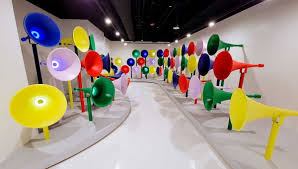
Interactive installations blur the line between artist and audience, transforming viewers into participants. These works often use sensors, lights, sound, or motion to respond directly to the presence or actions of the audience. Instead of passively observing, visitors shape the artwork in real time.
This participatory approach creates a unique experience for each viewer. Walking through a room might trigger a cascade of projected images, or touching a sculpture could produce music. By making the audience part of the creative process, interactive art fosters a deeper emotional connection.
Technology plays a key role in these installations. Artists incorporate augmented reality, virtual reality, and AI-driven responses to make the experience immersive. Public spaces, museums, and festivals are increasingly hosting such works, turning art into a shared social moment rather than a solitary observation.
Interactive installations also democratize art—anyone, regardless of background or artistic training, can engage with and influence the piece. They challenge the traditional definition of an artwork as something fixed, proving that art can be alive, evolving, and collaborative.
